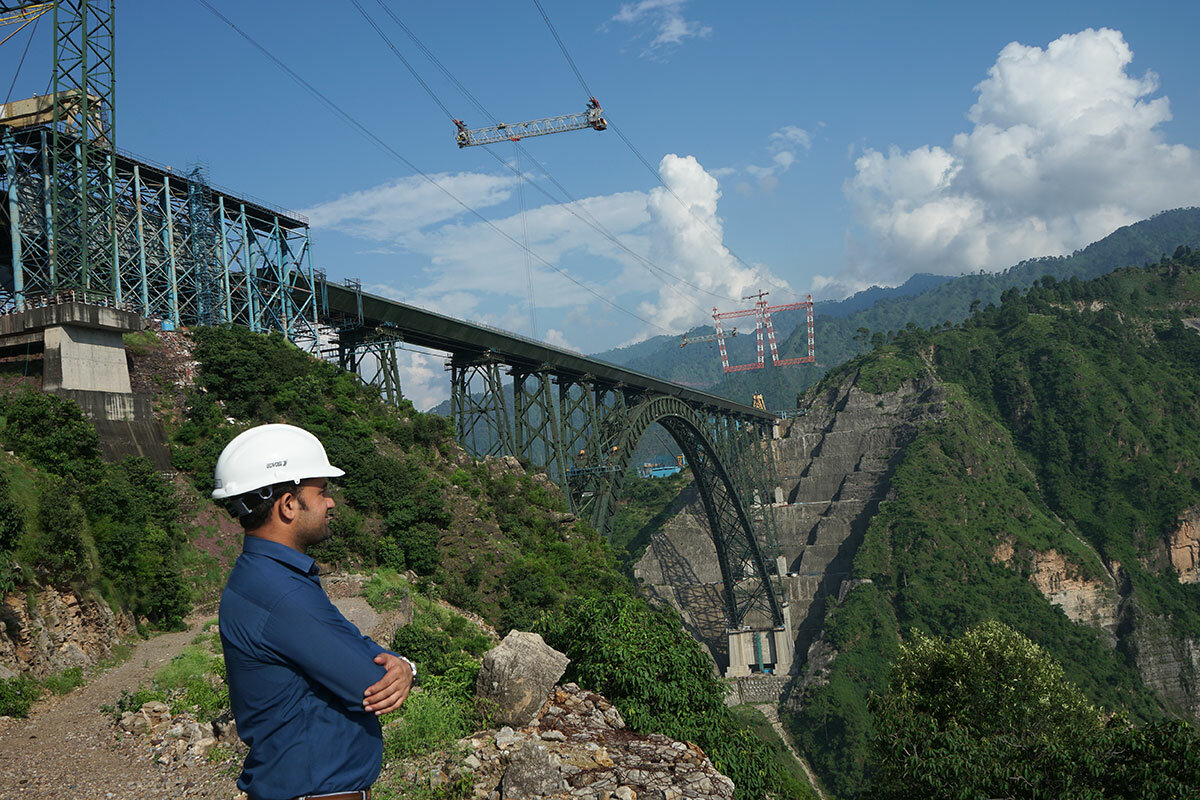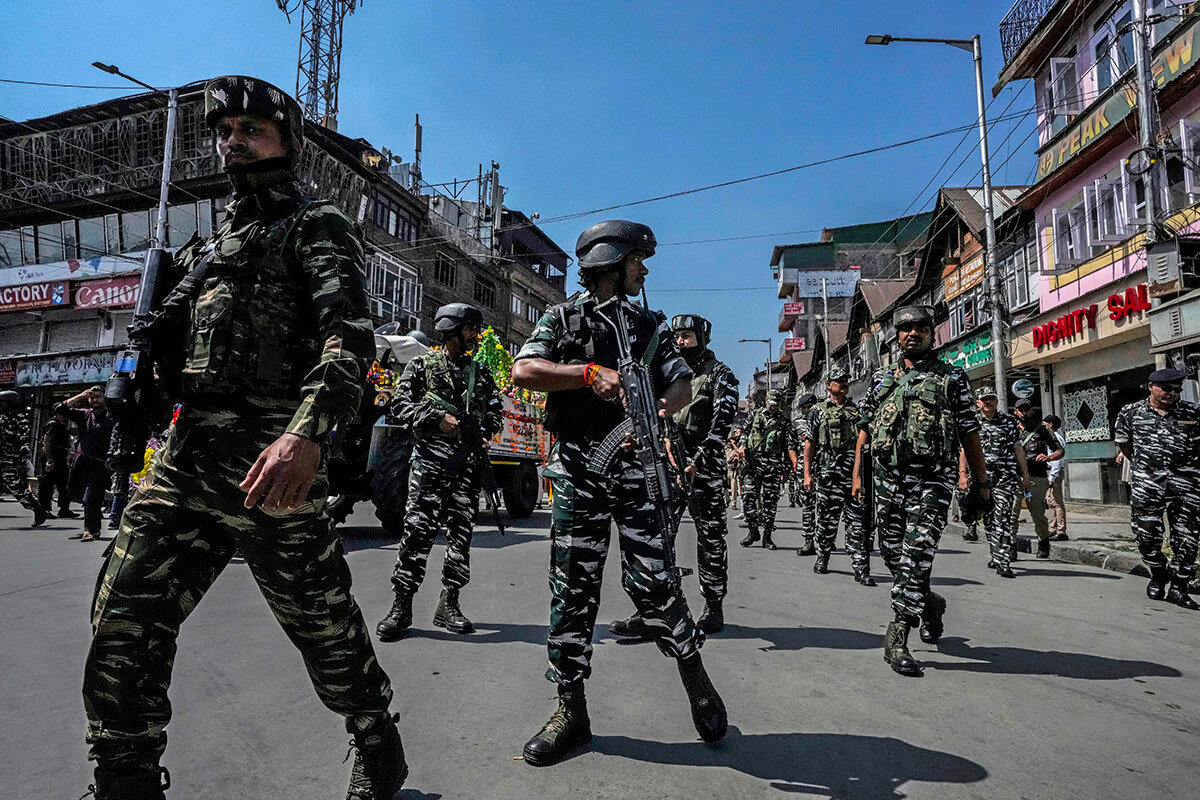India’s bridge to Kashmir: Path to prosperity or tool of control?
Loading...
| Reasi, India
The first rays of light, descending over Kashmir’s misty mountain peaks, reveal a massive steel arch that seems to float over gold-tinted clouds. Standing nearly 1,200 feet over the Chenab River, the recently completed structure is the world’s tallest railway bridge and will connect the remote region with mainland India’s massive rail network.
It took nearly two decades, and hundreds of workers and engineers toiling day and night, to build the steel and concrete bridge. Work on the final joint was finished in August.
“It was a daunting task,” says Rashmi Ranjan Mallick, deputy chief engineer of the project. “Building something in other parts of the world is tough, but building something in the Himalayas is altogether a different task.”
Why We Wrote This
A story focused onA record-breaking bridge is set to connect Kashmir to mainland India. The ambitious project has sparked hope and worry, and shows how development can be a double-edged sword.
But it’s more than an engineering marvel.
The Chenab Bridge, which is expected to start operating in the coming months after the connecting rail lines are finished, is cause for both hope and concern to many stakeholders in the region. For some, it promises prosperity in the form of new economic markets and freedom of mobility, as well as added security, with Indian troops being able to efficiently access contentious borders with Pakistan and China. But for many Kashmiris, whose region has been systematically stripped of its autonomy in recent years, the railway signals greater mainland control and unwanted transformation.
Junaid Ahmad, a Kashmiri student, worries that the railway will bring more instability than benefits to Kashmir, an already volatile region struggling with demographic transformation and a heightened military presence.
“India has a huge population of over 1.2 billion people,” he says, “and railways will certainly make it easy for outsiders to come to Kashmir and maybe settle here.”
Breaking through to a troubled region
Kashmir is one of the most militarized places in the world, with Pakistan and India fighting over the Muslim-majority territory since 1947. Polls have shown many in the Indian-controlled Kashmir want to merge with Pakistan or become an independent state, and in recent decades, authorities have struggled to contain separatist rebellions as well as tamp down violence by Indian security forces, who have been accused of grave human rights violations, including rape and extrajudicial killings.
The Chenab Bridge was announced in 2002 by then-Prime Minister Atal Bihari Vajpaye, as part of a broader railway project geared toward accelerating the region’s “socio-economic development, promoting national integration, and strengthening India’s security infrastructure.”
Communication with the region has always been tough due to its mighty mountain ranges. Even today, Kashmir has only one highway connecting it with India – and, by extension, the rest of the world – which regularly gets blocked due to landslides.
The railway line, however, is going to change that.
Two sections are already operational, but the most challenging part lies in a 69-mile stretch between Katra and Banihal, which will ultimately connect Kashmir with the mainland. This section snakes through the rugged Pir Panjal mountain range of the Himalayas, with the Chenab Bridge being the most ambitious of the 16 bridges and 15 tunnels involved in this line.
“This is an outstanding project with hardly any parallels around,” says Mr. Mallick, the engineer. “We have been able to create the first all-weather link to Kashmir. It is not only a great engineering work, but something which has huge significance for our country.”
He adds that it should only take a few more months to get the rest of the line finished, and the trains will start running shortly after that.
“The train is going to open up unimaginable possibilities; it will bring fortunes with it,” says Sagar Singh, who came from a nearby town with his friends to see the completed Chenab Bridge, and were excitingly taking pictures on his smartphone, just as they were on theirs.
But while the railway has prospects to boost the economy of the region and ease connectivity for native Kashmiris, experts say the main benefactor will undoubtedly be the Indian military.
Boosting military capacity
Authorities say the railway line is going to be a “game changer” for military supply chains in a region that faces hostile borders with both Pakistan and China.
“It will be a 10-time multiplier for our logistics system both in peace and definitely during war,” says a former Indian army officer, Maj. Gen. Amrit Pal Singh, who used to head operational logistics for the area.
New Delhi is hopeful that the train to Kashmir will give it a firmer grip on the region, both in terms of fighting the internal discontent and facing hostile neighbors.
“Military capability is measured not only in terms of soldiers and equipment but the ability to apply military force at selected areas,” says D.S. Hooda, former northern commander of the Indian army. “This requires infrastructure to move large forces. The railway line is a significant step in this direction.”
Yet for local Kashmiris, the situation is more complex.
Are the opportunities worth the risks?
“The rail will give easy access to faraway markets for Kashmiri produce like apples, the main produce from the region. But it will increase the flow of outsiders,” says Sheikh Showkat Hussain, a political observer from the region. And due to new policies, they may feel empowered to stay, he adds.
Since 2019, when India’s Bharatiya Janata Party government unilaterally revoked Kashmir’s limited autonomy and imposed a regionwide communication blackout to quell dissent, New Delhi has persistently pushed policies that would give nonlocals the same rights that native residents enjoy.
The Election Commission of India recently announced plans to give voting rights to people who are temporarily living in the region, a move that has stirred outrage among native Kashmiris and local political leaders. The move is expected to add about 2.5 million voters to the region, including Indian military personnel, marking a 30% increase in the electoral rolls.
There has been an increase in violence against minority Hindus and nonlocals since 2019. At least two dozen have been killed by rebels fighting New Delhi’s rule, with one group releasing a statement warning that “anyone involved in the demographic change of Kashmir will meet the same fate.”
Hundreds of local Hindus have fled from the region following the targeted killings and others have been protesting, demanding their safety and relocation. Some say the chaos isn’t worth the trade opportunity – especially considering the narrow nature of that opportunity.
“The traditional routes to west Punjab [in Pakistan] and to China remain cut,” says Dr. Sheikh Showkat, referring to Kashmir’s historical position at the crossroads of the Silk Road. “India says it is bringing connectivity to the region, but its [India’s] presence that has led to erection of walls.”









